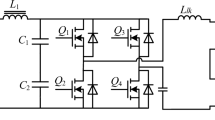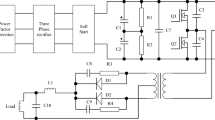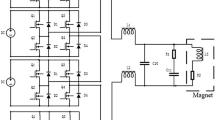Abstract
Purpose
The high-energy photon source (HEPS) is the first fourth-generation synchrotron photon source in China (Jiang et al. in Sci Sin Phys Mech Astron 44:1075–1094, 2014). The strip electrode and its power supply provide necessary hardware support for correcting the magnetic field of the wiggler as reported by Zhao and Yin (Particle accelerator technology, Higher Education Press, Beijing, 2006). The design of the conventional power supply for accelerators, with a large output current and high output voltage, making it easy to achieve high stability of the output current. The strip electrode power supply poses difficulties in achieving high stability due to its small output current and voltage. Because of size limitations, as well as the requirements of the power architecture, there are currently no commercial products for this type of power supply.
Methods
Designed and developed 32 strip electrode power supplies. Considering the large number of power supplies and limited space, a rack structure design was adopted, placing all power supplies in one rack. The main circuit of the power supply adopts a full bridge transformation structure (Chao et al. in Radiat Detect Technol Methods 6:470–478, 2022), and the control scheme adopts full digital control based on FPGA (Long and Cheng in At Energy Sci Technol 43:780–784, 2009). The power supply has two control modes: local operation and remote operation as reported by Lu (Particle accelerator technology, Hunan University, Changsha, 2010).
Results
The test shows that all power supplies meet the indicator requirements, with a stability of less than 100 ppm.
Conclusions
The strip electrode power supply can effectively correct the multipole integral field error and improve the integral field performance of the wiggler.
Similar content being viewed by others
Avoid common mistakes on your manuscript.
Introduction
The wiggler requires a total of 32 power supplies for integral field correction. Among them, 24 power supplies are supplied for the multipole field strip electrodes of the wiggler, which are copper strips with a length of about 5 m. The other 8 provide power to the windings at the end of the wiggler. The related parameters such as electrode resistance are shown in Table 1.
Considering the lower power of the power supply, the size can be minimized as much as possible. In the design, 32 set of power supplies have been designed into plug-in style and placed in a 19-inch rack. In terms of power supply control, all operations such as power on, off, and current setting can be achieved through the operation panel. In order to achieve remote control, a network communication interface with RJ45 network cable connector has been designed for the power supply. Each power supply can be individually configured with an IP address to achieve remote centralized control and facilitate operation by debugging personnel. The power supply integrates protection functions such as output overcurrent, output overvoltage, and input overcurrent, effectively improving the safety of the power supply. All information can be displayed on the operation panel of the power supply, achieving comprehensive and convenient human–machine interaction functions.
The design of the power supply mainly includes main circuit topology design, control circuit design, operation panel design, program design, and structural design. Figure 1 shows the overall block diagram of the power supply.
Main circuit topology design
The output current of the power supply is bipolar, so a full-bridge converter topology is adopted. Due to the low output power of the entire circuit, the H-bridge is driven by 2 sets of half-bridge driver chips which is more convenient [6]. The bootstrap circuit is used to drive two MOSFETs, one on the high side and one on the low side of the bridge arm, eliminating the need for separate power supplies for the drive [7]. Each MOSFET is equipped with an absorption circuit to reduce the reverse peak and output voltage ripple noise during the MOSFETs turning off. Figure 2 shows the main circuit structure diagram of the power supply.
Auxiliary power supply design
The entire power supply system requires various auxiliary power supplies to meet the requirements of isolation, driving, control, etc. In order to simplify power supply design and improve reliability, several integrated power modules are used to directly generate the required voltage. Although the multi-output switching power supply is more cost-effective, a simplified solution was adopted to avoid the complexity of debugging the multi-output switching power supply in a short period of time. Figure 3 shows the auxiliary power supply design.
Current sampling design
Considering that the current of this specification of power supply is only 6A and the performance requirements are a little lower, and considering the overall cost and internal size of the power supply, Hall current sensors are chosen. A standard source test was conducted on the selected Hall sensor, using a 6-A input current. With winding multiple turns, an 8 V voltage can be obtained on a 100-Ω sampling resistor. To reduce heating, the sampling resistor can adopt a structure with multiple parallel connections. Figure 4 shows the testing of the current Hall sensor.
To verify the feasibility of the Hall sensor scheme. Before use, stability testing was conducted on the Hall sensor. Using a standard source to output a precise current of 6A, the stability information is obtained through an LA100P Hall sensor and a 100-Ω sampling resistor [8]. Confirm that it can meet the usage requirements. The heating temperature of the Hall element is also within an acceptable range.
Control circuit design
The power supply control adopts high-precision fully digital closed-loop control method based on FPGA. The ADC adopts a chip with 18-bit resolution with low noise, low power, and other high performance [9]. In order to achieve Ethernet remote control, a network interface is designed on the control board. In order to facilitate communication with the power supply operation panel, another interface of RS232 designed to receive control information from the operation panel and achieve local control of the power supply.
The control circuit mainly includes FPGA core board interface circuit, peripheral ADC sampling circuit (Fig. 5), signal processing circuit, and input/output signal isolation circuit (Fig. 6) [10].
Operation panel design
The power supply can operate locally through the operation panel. The main function of the operation panel is to provide parameter setting and display output current value. The current setting point is set through a rotary encoder, and the given information is read by the microcontroller integrated on the operation panel. Display information such as current setting point and actual current output is shown on the OLED screen. At the same time, the panel also has other fundamental functions of turning on, off, and resetting through buttons. The operation panel provide a power switch button for turning on and off the main input of the power supply. The communication between the panel and the FPGA of the control board is completed through interface of RS232 to exchange the various information. The physical interface of Ethernet is used to connect with remote computers at the upper level through network cables. Figure 7 shows the design and actual appearance of the panel.
Programming
The program design of the power supply mainly includes ADC sampling, PID calculation, PWM generation, TCP/IP communication, RS232 communication program, and related protection logic design. ADS8382 is an 18-bit, fully differential pseudo bipolar input analog-to-digital converter with a sampling rate of up to 600 kHz, which communicates with FPGA through SPI [11]. PID calculation adopts positional PID algorithm, which adjusts the given and feedback error signals. Finally, dual PWM waveform based on the adjustment amount is generated, which acts on the driving circuit to complete the output of power.
The remote network controlling adopts W5500 as the network interface chip. The W5500 integrates a full hardware TCP/IP protocol stack, eliminating the process of developing TCP/IP using FPGA. FPGA only needs to access the registers of W5500 through SPI to achieve socket communication. The communication between FPGA and the operation panel is achieved through RS232. In the program, several sets of arrays are set to store the switch information of the power supply, current setting data, and current collection data, achieving the display of operation panel OLED screen information. These data include on/off, given, collected, faulty, remote control, or local control.
Structure design
The structural design mainly includes power supply structure design and rack structure design.
The power supply structure adopts a plug-in design, where the power circuit is concentrated on a PCB with a length of approximately 332.3 mm, a height of 100 mm, and a width of 61 mm. The control board is connected to the main circuit board through connectors. The power supply board is connected to the backplane of the rack using a 96-pin connector. Figure 8 shows a plug-in power supply.
Six plug-in power supplies and one DC source are installed together in a rack with a height of 3U. Because the outputs of power sources are not required for isolation each other, a single DC source is jointly used as the power supply. A switching power supply with an output voltage of 24 V and a total power of 350W is chosen as the DC source. A total of 6 sets such chassis are placed in a 19-inch, 2-m high rack. Figure 9 shows the arrangement of power supplies on the rack.
Output current calibration
After the production of the power supply was completed, the output currents of all power supplies were calibrated to minimize the error between the given and actual output currents of the power supply. The calibrated power supply has an accuracy of around 100 ppm. Table 2 shows the accuracy of different currents for a single power supply.
Stability test
An 8-h stability test was conducted on ± 6A of all 32 power supplies. The loads used in the test are all resistive loads. Table 3 shows the stability test results of all power supplies. The test results show that the 8-h stability of all power supplies can meet the requirement of 100 ppm.
The current stability data for 8 h is shown in the following Fig. 10. The data shows that the output current of the power supply is stable enough, and there are no abnormal jumping points.
Output voltage ripple
In Fig. 11, the low-frequency ripple display of the output voltage shows that the voltage ripple is stable, without spikes or fluctuation. By Fourier analysis, it can be seen that there are no obvious low-frequency ripple and no 50 Hz power frequency signal. In Fig. 12, the high-frequency ripple shows that the switching noise of the power supply is not significantly amplified. It also can be seen that the amplitude of the switching noise accounts for about 1mv of the total harmonic amplitude.
Conclusion
32 sets strip electrode power supplies designed and developed in house have excellent performance and reasonable structure, achieving error correction for the multipole integration field of the HEPS wiggler. Through actual load testing verification, all performance indicators of the developed power supplies meet the physical design requirements. At present, they have been applied in the experiments of HEPS wiggler.
References
X. Jiang, J.Q. Wang, Q. Qin et al., Chinese high energy photon source and the test facility. Sci. Sin. Phys. Mech. Astron. 44(10), 1075–1094 (2014) (in Chinese)
J. Zhao, Z. Yin, Particle accelerator technology (Higher Education Press, Beijing, 2006)
H. Chao, L. Fengli, G. Yao et al., Development of corrector magnet power supply for high energy photon source. Radiat. Detect. Technol. Methods 6, 470–478 (2022)
F. Long, J. Cheng, Design of a digital regulator based on field programmable gate array. At. Energy Sci. Technol. 43(9), 780–784 (2009) (in Chinese)
J. Lu, The research and design of magnet power supply digital module (Hunan University, Changsha, 2010) (in Chinese)
X. Guo, P. Liu, C. Han, B. Chen, Development of high precision and stability DC power supply prototype for high energy photon source. At. Energy Sci. Technol. 58, 1523 (2019) (in Chinese)
P. Liu, X. Wang, F. Long, Fast corrector power supply design for HEPS. Radiat. Detect. Technol. Methods 4, 56–62 (2020). https://doi.org/10.1007/s41605-019-0149-4
Datasheet of Hall sensor. https://www.lem.com/cn/product-list/la-150tpsp1
L. Peng, L. Fengli, A precision ADC sampling system design. Radiat. Detect. Technol. Methods 4, 182–189 (2020)
P. Liu, F.L. Long, Y.Z. Du, Design of precision acquisition system for precision power supply of photon source. Radiat. Detect. Technol. Methods 5, 586–593 (2021)
J. Lu, Y. Yan, J. Lv, Q. Li, F. Long, The design of AD/DA board used in digital power control model. Nucl. Electron. Detect. Technol. 43(1), 110–113 (2010) (in Chinese)
Author information
Authors and Affiliations
Corresponding author
Ethics declarations
Conflict of interest
On behalf of all authors, the corresponding author states that there is no conflict of interest.
Rights and permissions
Springer Nature or its licensor (e.g. a society or other partner) holds exclusive rights to this article under a publishing agreement with the author(s) or other rightsholder(s); author self-archiving of the accepted manuscript version of this article is solely governed by the terms of such publishing agreement and applicable law.
About this article
Cite this article
Liu, Y., Li, Y., Du, Y. et al. Design and development of strip electrode power supply for HEPS wiggler. Radiat Detect Technol Methods 8, 1155–1161 (2024). https://doi.org/10.1007/s41605-023-00432-x
Received:
Revised:
Accepted:
Published:
Issue Date:
DOI: https://doi.org/10.1007/s41605-023-00432-x
















